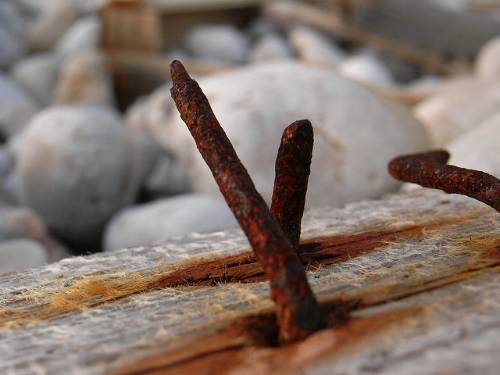Is your tetanus booster up to date?
/Rusty nails are not the only tetanus hazard Remigi Buj/Flickr
The safety-conscious gardener never goes digging without some basic gear like a sun hat and sunscreen, protective gloves and sturdy, closed-toe shoes.
There’s one more thing you shouldn’t leave home without: a valid tetanus booster. It’s not impossible that working in the yard might include that classic tetanus-inducing mishap, stepping on a rusty nail.
But there are a host of ways that you could encounter the evil bacteria Clostridium tetani, which is present in soil, dust and manures off all kinds. In fact, gardening, landscaping and yard work accounted for nearly 40 percent of the tetanus cases, according to the Centers for Disease Control. The organic gardener with manure-enriched soil, for instance, is working in an environment rich in tetanus spores.
Puncture wounds head the list of dangers, and the way these might occur are legion. Think of stabbing yourself with the rough edges of chicken wire fencing, with vicious rose thorns or with the business end of a pitchfork. Bug bites are a form of puncture wound, too, as are splinters from the worn handle of your faithful old shovel or the edges of your weathered potting table.
While fully half of tetanus cases do involve a puncture, other types of wounds also are vulnerable. Cuts were involved in 33 percent of reported cases, and scrapes another nine percent. Even minor injuries, if they are sustained outdoors, can be tetanus-prone.
The other name for tetanus is lockjaw, because early symptoms in this disease of the muscles and nerves include spasms in the jaw and difficulty swallowing.
Micrograph of tetanus bacteria Centers for Disease Control
In acute stages, victims suffer excruciating muscle spasms and seizures, strong enough to break bones. Patients can become so sensitive to disturbance that almost anything — a draft, a noise — can trigger convulsions and profuse sweating. And this goes on for four to six weeks.
John Roebling Sr., builder of the Brooklyn Bridge, died of tetanus after crushing his leg between a dock and the hull of a steel ship. The description of his hideous death in David McCullough’s book “The Great Bridge” (Touchstone Books, 1983) was so graphic and so awful that I have never forgotten it. I don’t balk when it comes to tetanus shots even though I like injections no more than the average coward.
Between 10 and 18 percent of the people who contract tetanus die from it, even today. Surviving victims and those who didn’t make it spent a month in the hospital on average, running up medical bills of $150,000 each — all for want of a cheap vaccine. None of those who contracted the disease were people current with their shots. The message here is plain: An ounce of prevention is worth the proverbial pound of cure.
It isn’t children who are most at risk, since vaccinations that begin in infancy include the standard tetanus-diphtheria shot and another booster is usually administered at age 10 or 11. But boosters are required once every 10 years thereafter to maintain immunity, a fact we grown-ups sometimes forget.
More than half of American adults over the age of 20 do not have protection because they have failed to get routine shots once a decade, according to the National Foundation of Infectious Disease. Active adolescents and young adults are vulnerable, but fully 70 percent of the cases reported in the past 20 years were in adults over the age of 40, the older but not wiser crowd.
Having learned with a quick phone call to my doctor that I was a year overdue, I got the shot. I want to be able to play in the dirt without fear. I want the same for all of you, dear readers. If you haven’t had a booster in 10 years or more, make an appointment today. Better safe than sorry.


